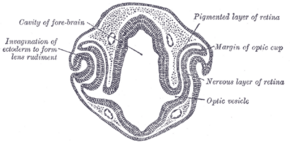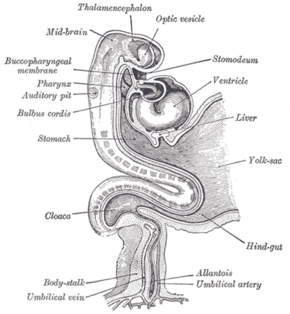Biology:Optic vesicle
From HandWiki
| Optic vesicle | |
|---|---|
 Transverse section of head of chick embryo of forty-eight hours’ incubation. (Optic vesicle labeled at lower right.) | |
 | |
| Details | |
| Carnegie stage | 11 |
| Gives rise to | Human eyes |
| Identifiers | |
| Latin | vesicula optica; vesicula ophthalmica |
| Anatomical terminology | |
The eyes begin to develop as a pair of diverticula from the lateral aspects of the forebrain. These diverticula make their appearance before the closure of the anterior end of the neural tube; after the closure of the tube they are known as the optic vesicles. Previous studies of optic vesicles suggest that the surrounding extraocular tissues - the surface ectoderm and extraocular mesenchyme - are necessary for normal eye growth and differentiation.[1]
They project toward the sides of the head, and the peripheral part of each expands to form a hollow bulb, while the proximal part remains narrow and constitutes the optic stalk.
Additional images
References
- ↑ Fuhrmann, S. (2010). Eye Morphogenesis and Patterning of the Optic Vesicle. Current Topics in Developmental Biology Invertebrate and Vertebrate Eye Development, 61-84. doi:10.1016/b978-0-12-385044-7.00003-5
- Fuhrmann, S. (2010). Eye Morphogenesis and Patterning of the Optic Vesicle. Current Topics in Developmental Biology Invertebrate and Vertebrate Eye Development, 61-84. doi:10.1016/b978-0-12-385044-7.00003-5
External links
- eye-012—Embryo Images at University of North Carolina
- Overview at vision.ca
- Overview at temple.edu


